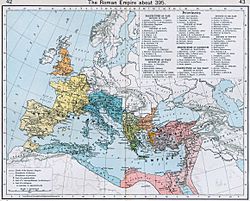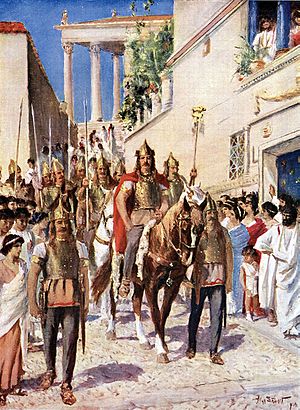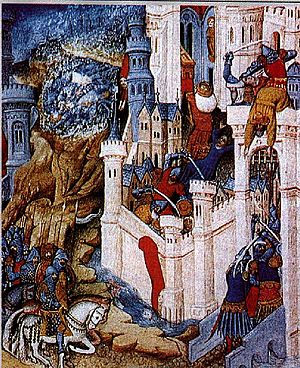Sack of Rome (410) facts for kids
Quick facts for kids Sack of Rome (410) |
|||||||
|---|---|---|---|---|---|---|---|
| Part of the fall of the Western Roman Empire | |||||||
 The Sack of Rome by Évariste Vital Luminais (1821-1896). New York, Sherpherd Gallery. |
|||||||
|
|||||||
| Belligerents | |||||||
| Visigoths | Huns |
||||||
| Commanders and leaders | |||||||
| Alaric I Ataulf |
Honorius | ||||||
| Strength | |||||||
| Possibly 40,000 soldiers Unknown number of civilian followers |
Unknown | ||||||
| Casualties and losses | |||||||
| Unknown | Unknown | ||||||
The sack of Rome on August 24, 410 AD, was a major event. It happened when the Visigoths, led by their king, Alaric, attacked the city. At this time, Rome was no longer the capital of the Western Roman Empire. The capital had moved to Mediolanum (now Milan) in 286 and then to Ravenna in 402.
Even so, Rome was still seen as "the eternal city" and a very important spiritual center. This was the first time in almost 800 years that Rome had been captured by an enemy from outside. The event shocked everyone, both friends and enemies of the Empire. Many people saw the sacking of 410 as a key moment in the fall of the Western Roman Empire. St. Jerome, who lived in Bethlehem, wrote: "the city which had taken the whole world was itself taken."
Contents
Why Did the Visigoths Attack Rome?
The Germanic tribes had changed a lot after hundreds of years of contact with the Roman Empire. Their populations grew, their economies got stronger, and their groups became larger. This made them powerful enough to challenge Rome.
The Goths and the Huns
The Goths were one of these Germanic tribes. They had invaded the Roman Empire many times since 238 AD. But in the late 4th century, the Huns started invading the lands of the Germanic tribes. This pushed many of them, including the Goths, into the Roman Empire.
In 376, the Huns forced many Therving Goths, led by Fritigern, to seek safety in the Eastern Roman Empire. Soon after, the Goths faced hunger, high taxes, and bad treatment from the Romans. This made them turn against the empire.
Gothic Rebellion and Alaric's Rise
The Goths rebelled and began to loot and raid areas in the eastern Balkans. A Roman army, led by the Eastern Roman emperor Valens, marched to stop them. At the Battle of Adrianople in 378, Fritigern completely defeated Emperor Valens, who died in the battle.
Peace was made in 382 when the new Eastern emperor, Theodosius I, signed a treaty with the Thervings. These Goths became known as the Visigoths. The treaty made the Visigoths allies of the empire, called foederati. They were given land in Dacia and Thrace. This land was still Roman, and the Visigoths had to provide military service. But they were allowed to govern themselves.
Around 391, a Gothic leader named Alaric was declared king by a group of Visigoths. He then led an invasion into Eastern Roman territory. Alaric was defeated by Theodosius and his general Flavius Stilicho in 392. This forced Alaric to become a Roman ally again.
In 394, Alaric led Visigoth soldiers as part of Theodosius' army to invade the Western Roman Empire. At the Battle of the Frigidus, many Visigoths died fighting the Western Roman army. Theodosius won the battle, and Alaric was praised for his bravery. However, Alaric felt that Roman generals had used the Goths to do most of the fighting. He was also angry that he was not given a higher position in the Roman government.
Alaric's Invasions Begin
When Theodosius died in 395, the Visigoths believed their treaty with Rome was over. Alaric quickly led his warriors back to their lands. He gathered most of the Goths in the Danubian provinces and rebelled. They invaded Thrace and moved close to the Eastern Roman capital, Constantinople. At the same time, the Huns invaded Asia Minor.
The death of Theodosius also caused political problems. His sons, Honorius and Arcadius, became emperors of the West and East, but they were young. A power struggle began between Stilicho, who was in the West, and Rufinus, a powerful official in the East.
Rufinus made a deal with Alaric to get him to leave Constantinople. Alaric then marched to Greece, looting the area. Stilicho, a powerful Roman general, led an army from Italy to stop Alaric. Stilicho trapped Alaric in Thessaly, but he did not attack. Eventually, Emperor Arcadius ordered Stilicho to leave.
Stilicho obeyed, sending his Eastern troops to Constantinople and taking his Western troops back to Italy. The Eastern troops were led by a Goth named Gainas. When Rufinus met these soldiers, he was killed in November 395.
Stilicho's departure allowed Alaric to plunder much of Greece. This included Piraeus, Corinth, Argos, and Sparta. Athens paid a ransom to avoid being sacked. In 397, Stilicho returned to Greece. After some fighting, he trapped Alaric again. But Stilicho once more retreated to Italy, and Alaric moved into Epirus.
Historians disagree on why Stilicho failed to defeat Alaric. Some think his army was not reliable. Others suggest he made a secret deal with Alaric. Whatever the reason, Stilicho was declared an enemy in the Eastern Empire.
Alaric's actions in Epirus led the Eastern Roman government to offer him a deal in 398. They made Alaric a Roman general, giving him the command he wanted. This allowed him to get resources and weapons in his province. Meanwhile, Stilicho put down a rebellion in Africa and strengthened his power in the West.
Visigoths Invade Italy (First Time)
In 400, Alaric lost his Roman title. Also, many Gothic soldiers and their families were killed in a riot in Constantinople. With these events, Alaric felt unsafe in the East. So, while Stilicho was busy fighting other invaders, Alaric led his people into Italy in 401. They faced little resistance and besieged Mediolanum, the Western Roman capital.
Stilicho, with new allies, lifted the siege. Alaric retreated to Pollentia. On Easter Sunday, April 6, 402, Stilicho launched a surprise attack at the Battle of Pollentia. The battle was a draw. Alaric then fell back. The two armies fought again at the Battle of Verona, where Alaric was defeated.
After this, some Goths left Alaric's army and joined the Romans. Alaric and his army then moved to the borderlands near Dalmatia and Pannonia. Emperor Honorius, scared after Mediolanum was almost captured, moved the Western Roman capital to Ravenna. Ravenna was easier to defend with its swamps and had access to the sea for escape.
Alaric later became an ally of Stilicho. They planned to claim a Roman province for the Western Empire. In 405, Stilicho named Alaric a general for this province. However, a Goth named Radagaisus invaded Italy that same year, putting these plans on hold. Stilicho and the Romans defeated Radagaisus in 406. Many of Radagaisus' Goths were forced into Roman military service or enslaved.
In 407, Stilicho turned his attention back to the province he wanted. But then, many Vandals, Suebi, and Alans crossed the Rhine river and flooded into Gaul. This caused a rebellion in Rome under a new leader, Constantine III. Stilicho made peace with the Eastern Roman Empire in 408. This meant Alaric and his Visigoths were no longer as useful to Stilicho.
Alaric then took control of parts of Noricum and upper Pannonia in 408. He demanded a huge payment of gold (about 288,000 solidi). He threatened to invade Italy if he didn't get it. Stilicho had a very hard time convincing the Roman Senate to pay this ransom. This payment was meant to buy a new alliance with Alaric, who was supposed to fight Constantine III. The debate over paying Alaric weakened Stilicho's relationship with Honorius.
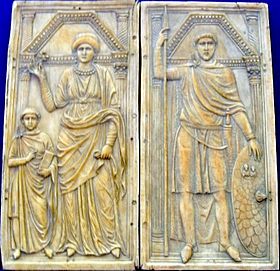
Before the payment could be made, the Eastern Roman Emperor Arcadius died in May 408. His young son, Theodosius II, became emperor. Honorius wanted to go East to help his nephew, but Stilicho convinced him to stay. Stilicho offered to go instead.
However, a Roman official named Olympius, who was Stilicho's enemy, spread false rumors. He claimed Stilicho planned to put his own son on the Eastern throne. Many people believed these rumors. Roman soldiers rebelled and started killing officials who supported Stilicho. Stilicho's own troops offered to fight the rebels, but Stilicho stopped them. He went to Ravenna to meet with the Emperor.
Honorius, now believing the rumors, ordered Stilicho's arrest. Stilicho sought safety in a church, but he was tricked into coming out. He was arrested and told he would be executed. Stilicho refused to let his followers fight back, and he was executed on August 22, 408. This stopped the payment to Alaric and his Visigoths.
Stilicho, who was half-Vandal and half-Roman, is seen as the person who kept the Western Roman Empire from falling apart for 13 years. His death had a huge impact on the West. His son was also executed shortly after.
Olympius took Stilicho's place as the powerful figure behind the emperor. His new government was very anti-Germanic. Roman soldiers began killing allied barbarian soldiers and their families in Roman cities. Thousands of them fled Italy and sought safety with Alaric in Noricum. Some historians believe as many as 30,000 fighting men joined Alaric.
Visigoths Invade Italy (Second Time)
First Siege of Rome
Alaric tried to make a deal with Honorius. He asked for hostages, gold, and permission to move to Pannonia. But Honorius refused. Alaric, knowing Italy's defenses were weak, invaded in early October 408, just weeks after Stilicho's death. He also asked his brother-in-law Ataulf to join him with more soldiers.
Alaric and his Visigoths sacked Ariminum and other cities as they moved south. Their march was easy, as if they were going to a festival. The city of Rome had about 800,000 people, making it the largest city in the world. The Goths under Alaric began to besiege the city in late 408.
Panic spread through Rome. Some people tried to bring back old pagan rituals to protect the city. Even Pope Innocent I agreed, as long as it was done privately. But the pagan priests said the sacrifices had to be public, so the idea was dropped.
Serena, Stilicho's wife and a cousin of Emperor Honorius, was in the city. The Roman people wrongly believed she was helping Alaric. Galla Placidia, the emperor's sister, was also trapped in the city. She agreed to Serena's execution.
Hopes of help from the government faded as the siege continued. Alaric took control of the Tiber River, cutting off supplies to Rome. Food became scarce. Starvation and disease quickly spread.
The Roman Senate sent two messengers to Alaric. When the messengers boasted that Romans were ready to fight, Alaric laughed. He said, "The thickest grass is easier to cut than the thinnest." The messengers asked what it would take to lift the siege. Alaric demanded all the gold, silver, household goods, and barbarian slaves in the city. When asked what would be left for the citizens, Alaric replied, "Their lives."
In the end, Rome had to give the Goths a huge amount of wealth. This included 5,000 pounds of gold, 30,000 pounds of silver, and many valuable goods. Many barbarian slaves also fled to Alaric, increasing his army to about 40,000.
To raise the money, Roman senators had to contribute. This led to corruption, and they still didn't have enough. So, the Romans melted down pagan statues and shrines to make up the difference. Emperor Honorius agreed to the payment. The Visigoths then lifted the siege and left for Etruria in December 408.
Second Siege of Rome
In January 409, the Senate sent a group to the emperor in Ravenna. They wanted Honorius to make peace with the Goths. They also offered Roman noble children as hostages to the Goths to ensure peace. Alaric would then become an ally of the Roman Empire again. Honorius, influenced by Olympius, refused. He called for 6,000 soldiers from Dalmatia to defend Rome. But their commander marched them into Etruria, where Alaric's army attacked them. Almost all were killed or captured.
A second group, including Pope Innocent I, was sent to Honorius to beg him to accept the Visigoths' demands. The government also learned that Ataulf, Alaric's brother-in-law, was coming to Italy with more Goths.
Honorius gathered all available Roman forces. He sent 300 Huns under Olympius to stop Ataulf. They fought near Pisa. Despite claims of killing many Goths, Olympius was forced to retreat to Ravenna.
This failure caused Olympius to lose power and flee. Jovius, a friend of Alaric's, replaced Olympius. The new government was open to talks. Alaric met Jovius and presented his demands. He wanted yearly payments of gold and grain, and land in Dalmatia, Noricum, and Venetia for his people. Jovius also suggested to Honorius that if Alaric was made a Roman general, he might ask for less. Honorius rejected the idea of giving Alaric a Roman office and sent an insulting letter to Alaric.
Alaric was furious and stopped negotiations. Honorius was now set on war. Alaric soon changed his mind when he heard Honorius was trying to hire 10,000 Huns to fight the Goths. He sent Roman bishops to Honorius with new, more moderate terms. He no longer wanted a Roman office or gold payments. He only asked for land in Noricum and grain. But Honorius' government, committed to war, rejected the offer. Alaric then marched on Rome. The 10,000 Huns never arrived.
Alaric took Portus (Rome's port) and began a second siege of Rome in late 409. Facing hunger and disease again, the Senate met with Alaric. He demanded they choose their own emperor to challenge Honorius. They chose an elderly man named Priscus Attalus, who was a pagan but agreed to be baptized. Alaric was made a general in this new government, and the siege was lifted.
Heraclian, the governor of the rich province of Africa, remained loyal to Honorius. Attalus sent a Roman force to defeat him, but he refused to send Gothic soldiers. Attalus and Alaric then marched to Ravenna, forcing some cities to submit to Attalus.
Honorius was very scared and prepared to flee to Constantinople. But 4,000 Eastern Roman soldiers arrived at Ravenna to defend the city. This strengthened Honorius' resolve.
Heraclian defeated Attalus' force and cut off food supplies to Rome, threatening another famine. Alaric wanted to send Gothic soldiers to Africa, but Attalus refused, not trusting the Visigoths. Alaric, advised by Jovius, decided to remove his puppet emperor. He stripped Attalus of his title in the summer of 410. Alaric then tried to negotiate with Honorius again.
The Final Siege and Sack of Rome
Honorius arranged a meeting with Alaric outside Ravenna. As Alaric waited, Sarus, an enemy of Ataulf and now allied with Honorius, attacked Alaric and his men. Alaric survived this attack. Outraged by this betrayal and frustrated by all the failed talks, he gave up on negotiating. He headed back to Rome, besieging it for the third and final time.
On August 24, 410, the Visigoths entered Rome through its Salarian Gate. Some say it was opened by betrayal, others say it was due to hunger. The Visigoths looted the city for three days.
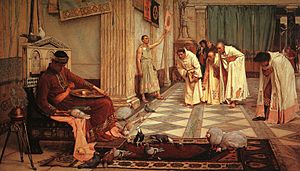
Many of the city's great buildings were ransacked. This included the mausoleums of Augustus and Hadrian, where many past emperors were buried. The ashes in their tombs were scattered. All movable valuable goods were stolen.
The Goths spared the two main churches connected to Peter and Paul. However, they stole a huge, 2,025-pound silver item from the Lateran Palace. Damage to buildings was mostly limited to areas near the old Senate house and the Salarian Gate. The Gardens of Sallust were burned and never rebuilt. The Basilica Aemilia and the Basilica Julia were also burned.
The people of Rome were devastated. Many Romans were taken captive, including the Emperor's sister, Galla Placidia. Some citizens were later ransomed, while others were sold into slavery.
Despite the looting, the sack was somewhat controlled. There was no widespread killing or enslavement of everyone in the city. The two main churches of Peter and Paul were made safe places. Most buildings and monuments survived intact, though their valuables were taken.
Refugees from Rome fled to the province of Africa, as well as Egypt and the East. Some refugees were robbed as they sought safety.
What Happened After the Sack?
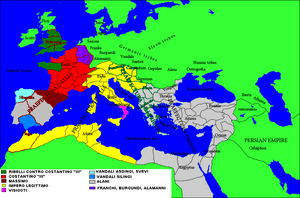
After three days of looting, Alaric quickly left Rome and headed for southern Italy. He took the city's wealth and a valuable hostage, Galla Placidia, Emperor Honorius' sister. The Visigoths raided Campania, Lucania, and Calabria. They sacked Nola and perhaps Capua. They planned to invade Sicily and Africa, but a storm destroyed their ships.
Alaric died of illness in Consentia in late 410, just months after the sack. Legend says he was buried with his treasure in the bed of the Busento river. The slaves who buried him were then killed to keep the location a secret. The Visigoths chose Ataulf, Alaric's brother-in-law, as their new king. The Visigoths then moved north towards Gaul. Ataulf married Galla Placidia in 414 but died a year later. The Visigoths later formed the Visigothic Kingdom in southwestern Gaul in 418. They would also help the Western Roman Empire fight Attila the Hun at the Battle of the Catalaalaunian Fields in 451.
The Visigothic invasion of Italy caused land taxes to drop greatly in the affected provinces. Wealthy Romans stopped supporting public buildings and monuments in south-central Italy after the looting. The population of Rome itself fell from 800,000 in 408 to 500,000 by 419.
This was the first time Rome had been sacked in almost 800 years. It showed how weak the Western Roman Empire had become. People across the Empire were shocked, as Rome was seen as the eternal city and the heart of their empire. The Eastern Roman Emperor Theodosius II declared three days of mourning. St. Jerome wrote sadly, "If Rome can perish, what can be safe?"
At this time, the Roman Empire was still dealing with religious conflict between pagans and Christians. Both sides used the sack to support their beliefs. Some Christians believed the sack was God's anger against a proud city. They also thought God's kindness kept the sack from being too severe. Other Romans felt the sack was punishment for turning away from the old pagan gods. A pagan historian believed that Christianity had weakened the Empire.
The attacks on Christianity led Saint Augustine to write a famous book, The City of God. This book became very important for Christian thought.
The sack was the result of many problems facing the Western Roman Empire. Rebellions and new leaders weakened the Empire as it faced outside invasions. These issues permanently harmed the stability of the Roman Empire in the west. The Roman army also became more barbarian and less loyal. A more severe sack of Rome by the Vandals happened in 455. The Western Roman Empire finally collapsed in 476 when the Germanic leader Odovacer removed the last Western Roman Emperor, Romulus Augustulus. He then declared himself King of Italy.
See also
 In Spanish: Saqueo de Roma (410) para niños
In Spanish: Saqueo de Roma (410) para niños
- Gothic War (376–382)
- Visigothic Kingdom
- Fall of the Western Roman Empire
- Sack of Rome


